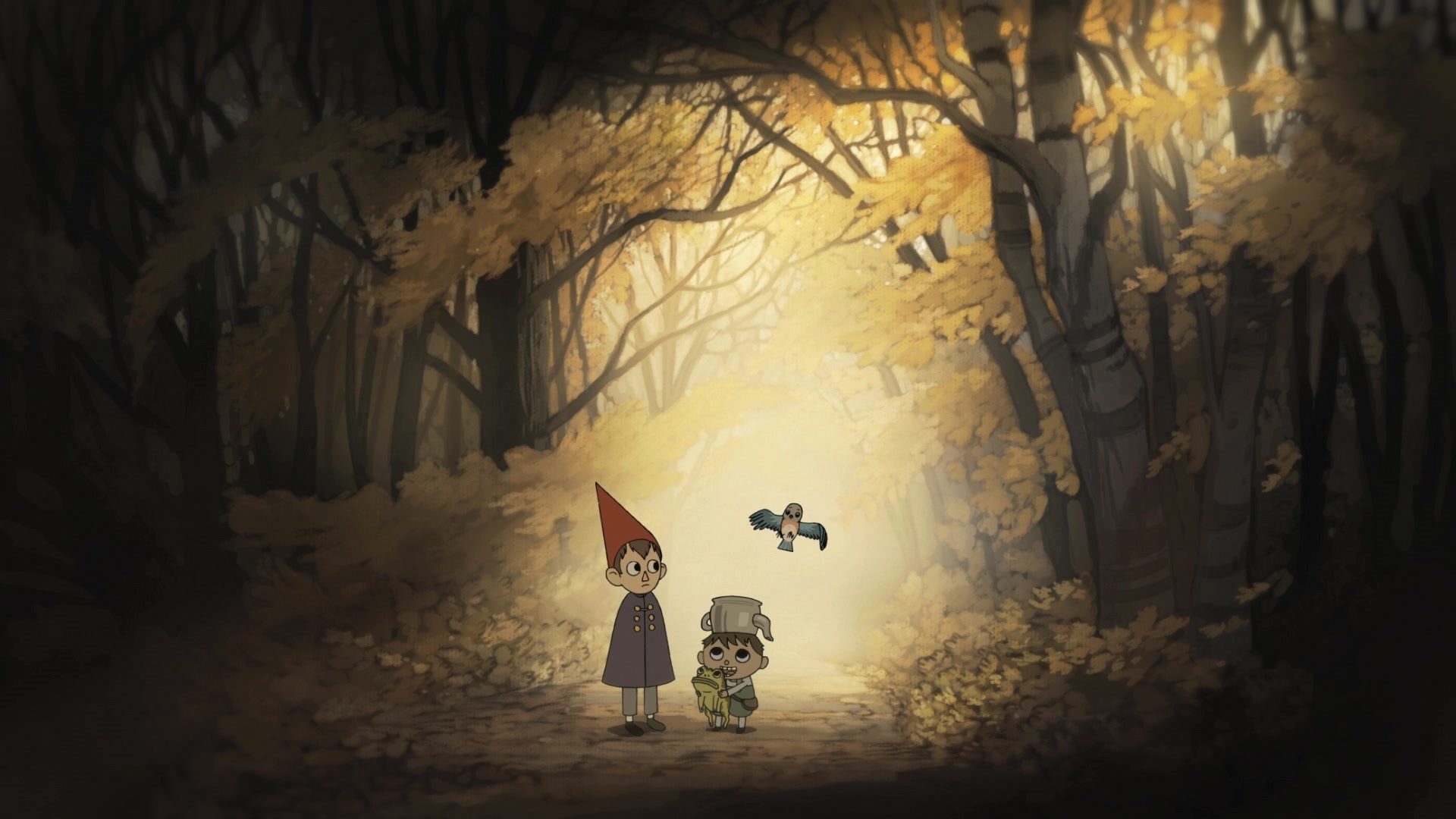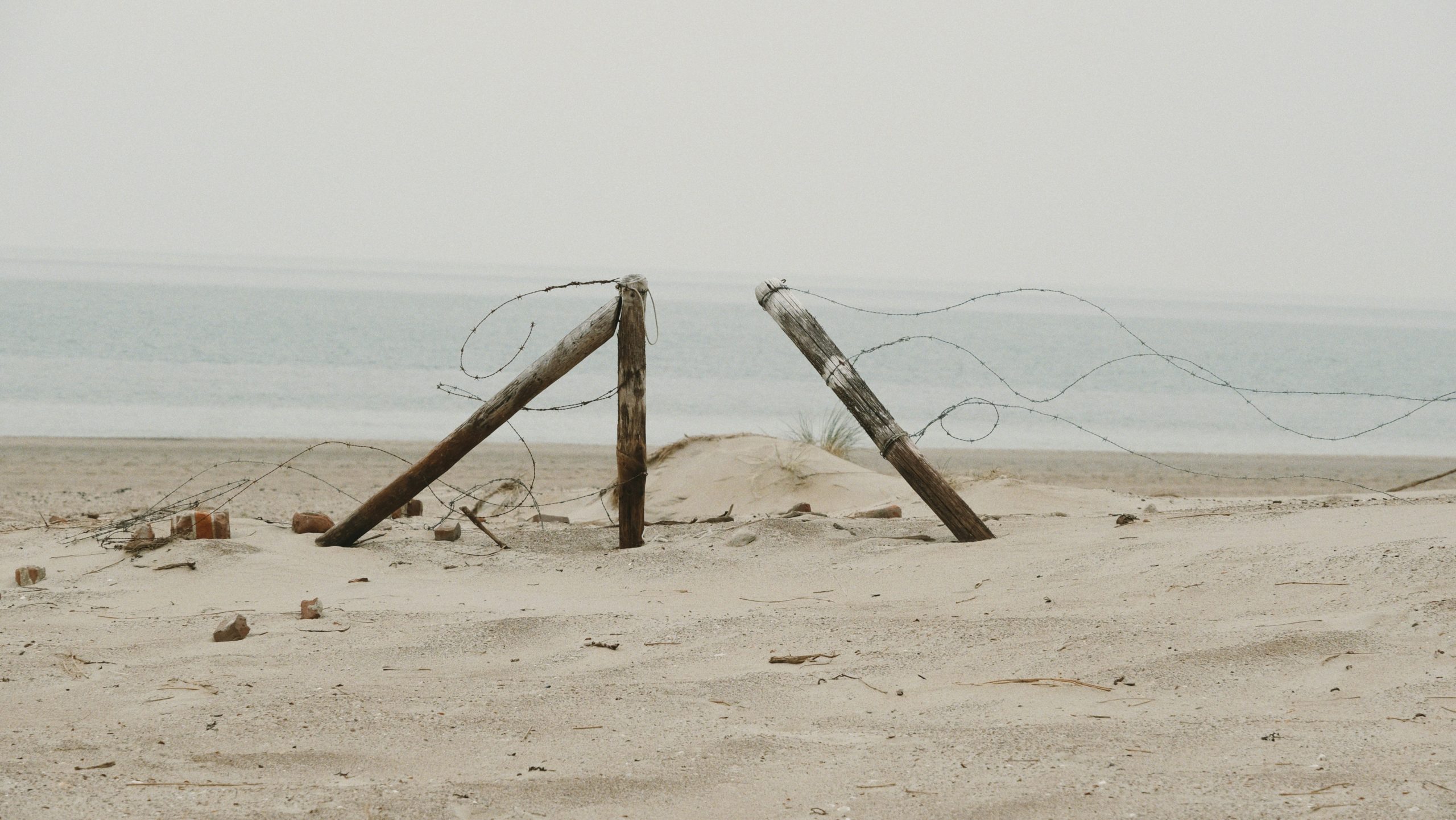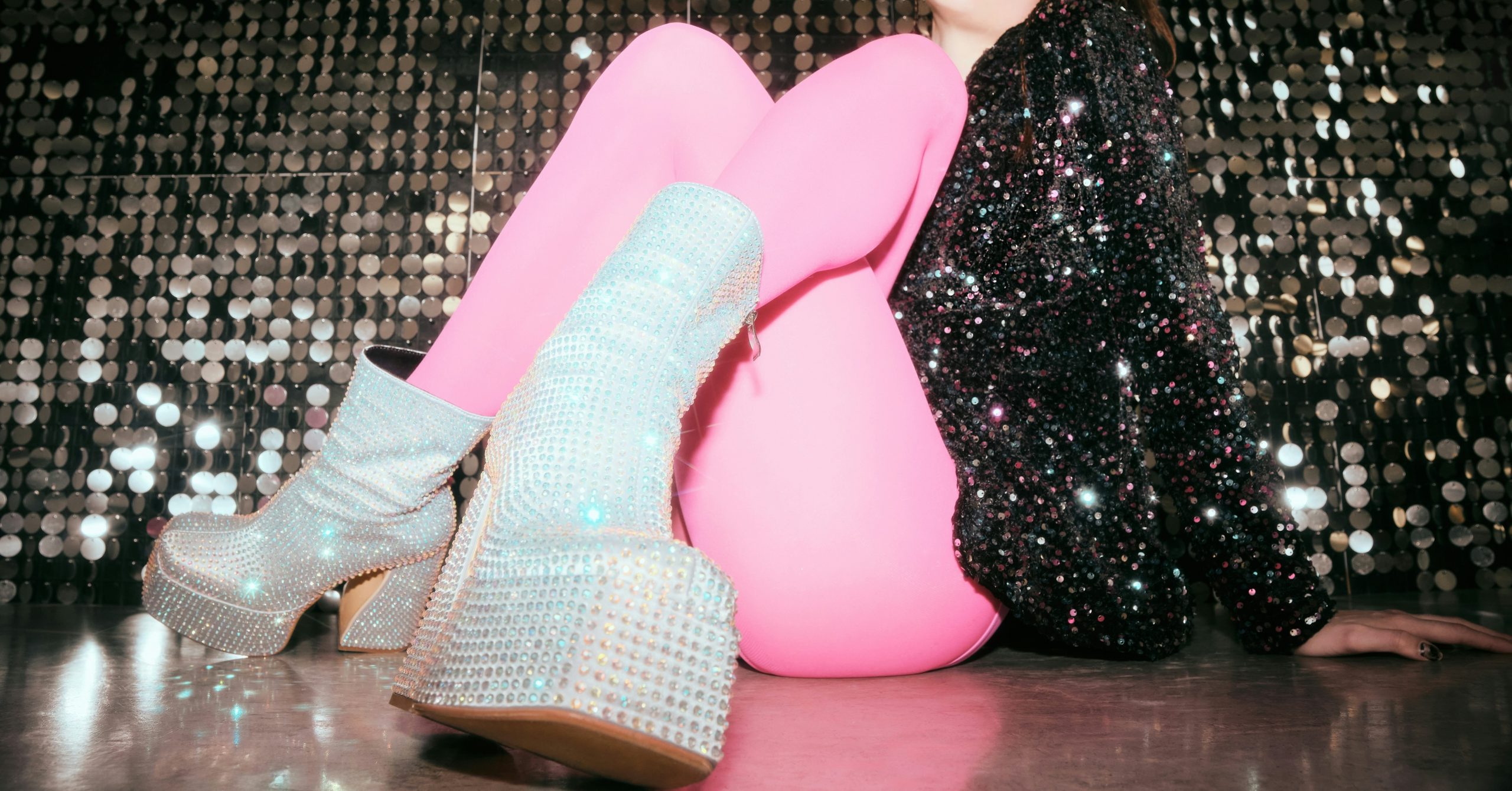Lit Mags
Even I Don’t Know Why I’m at This Baptism
"Godfather" from THE BOUNDARIES OF THEIR DWELLING by Blake Sanz, recommended by Clare Beams

Introduction by Clare Beams
I was often happiest in high school math class when things took a turn toward abstraction, and I remember the day we talked about Zeno’s Paradox better than I remember most days. We were learning about asymptotes, I think, but the concept caught me for its resonance beyond the graphs on the board. The way I remember it goes something like this: if you close the distance between yourself and an object by halves each time, you will never actually reach that object, because any space, no matter how infinitesimally small, can always be divided in half again. You must travel halfway before traveling the whole way, and there are infinite halves. You can’t finish something that’s infinite. You can’t actually touch.
 I thought about Zeno again while I was reading Blake Sanz’s debut collection The Boundaries of Their Dwelling, because there’s something asymptotic about these characters. They approach and approach—they are powerfully and movingly drawn to approach—and yet so often they can’t quite seem to reach one another. Their efforts at reaching are thwarted, or they have to happen indirectly, through mediation of some kind, or they’re misdirected, mistranslated, misunderstood. For years one character possesses just a single picture of the brother she’s never met, in which his face is turned away. Another character gives a grieving widow a gift saturated with meanings, at least for him, but can never be sure what meanings she’s taken from it. And centrally, crucially, a son, Tommy, longs for connection with his father, Manuel, and in the end receives it—maybe, partially—only through a shared reaction to a story someone else is telling.
I thought about Zeno again while I was reading Blake Sanz’s debut collection The Boundaries of Their Dwelling, because there’s something asymptotic about these characters. They approach and approach—they are powerfully and movingly drawn to approach—and yet so often they can’t quite seem to reach one another. Their efforts at reaching are thwarted, or they have to happen indirectly, through mediation of some kind, or they’re misdirected, mistranslated, misunderstood. For years one character possesses just a single picture of the brother she’s never met, in which his face is turned away. Another character gives a grieving widow a gift saturated with meanings, at least for him, but can never be sure what meanings she’s taken from it. And centrally, crucially, a son, Tommy, longs for connection with his father, Manuel, and in the end receives it—maybe, partially—only through a shared reaction to a story someone else is telling.
To borrow one of Blake Sanz’s own gorgeous lines, “Ultimately, you see the beauty only peripherally.”
Tommy and Manuel thread their way through much of this collection, and they’re here in “Godfather,” the story that’s published below, too. But our narrator this time is peripheral to both of their lives. Keith is a visitor in the world of the story he tells us, and he’s held at a distance from that world even as he’s trying to occupy it: we watch as he’s conscripted into participating in a baptism in a rural church whose rites he can’t directly decipher, because barriers of language and culture and tradition get in the way. To understand the moment he’s standing in, then, he has to use other means. The power of what he nonetheless discovers overwhelms me.
It is my absolute pleasure to introduce this story from Blake Sanz to you, reader, in all its power, all its revelation. Because that’s the paradox part of Zeno’s Paradox: sometimes you do connect in the end, somehow, even without quite touching. You can see a lot without quite looking at it.
Now, please, go ahead: see what you can see.
– Clare Beams
Author of The Illness Lesson
Even I Don’t Know Why I’m at This Baptism
Blake Sanz
Share article
Electric Lit is just $4,000 away from our year-end fundraising goal of $35,000! We need to hit this target to get us through the rest of 2025, and balance the budget for 2026. Please give today! DONATE NOW.
“Godfather” by Blake Sanz
To grant Mercedes’s wish, we had to find this old priest in a cheap resort town called Tecolutla; if I was okay with it, the we should include me. Or anyway, that’s what Manuel told me over the phone that morning. “She wants you to be there,” he added. He told me how things had gone the night before when they all got back to his apartment from our final planning session at the Hotel California. The argument started innocently enough. He and Tommy had needled Mercedes about this baptism business. Why expose Tita to anyone official in Mexico, they argued. The fewer to know about her before she crosses, the better. Wouldn’t there be a document certifying the rite? Couldn’t the certificate of baptism later be used against them? Or, might it not work the other way? Wouldn’t a priest require a birth certificate to perform the ceremony? And in that case, how would it be possible to find a priest willing to baptize the child on such short notice?
This had all sounded like bullshit to Mercedes. She felt ganged up on. She told them flatly that she didn’t care what the rules were, and she didn’t care about anything so petty as the bureaucracy behind a birth certificate. What was that in the face of a child’s soul? What was that in the face of performing a rite that that been performed on every single member of every single child in her family, going back as far as the time of the mixed-race great-grandchildren of Cortés? “Híjole,” she had said, “my mother and father would have wanted this!”
This, the trump card.
Tommy and Manuel let it drop. Tommy explained to his father: the only reason she’d ever gone to America—Louisiana, at that—in the first place was that her mother had been murdered when she was a girl. “At the Acteal massacre,” he said. “The one at the church in the jungle. The day her husband disappeared. Her parents, they were churchgoing people. Very devout.” And so, on Mercedes’s behalf, at Tommy’s begrudging behest, Manuel was calling to see if I would come.
“Where is Tecolutla?” I asked. “And why there? Why not here, in Poza Rica?”
“An hour away. My mother had me baptized at the church there. The same old priest still runs that diocese,” he said. It was the only religious place in the world, he reasoned, where his name might have any pull, where he could ask a priest to do something like this. He’d made a few calls and arranged for the old man to perform the ceremony.
What was that in the face of a child’s soul?
We took off late that morning, scrunched together in Manuel’s truck, four of us in a row with the baby on Mercedes’s lap. The truck’s cabin jostled us about as we rolled over uneven roads with holes from where the rain had washed them out. The road cut through tiny towns carved out of the jungle that surrounded us. Every few miles, a street side vendor sold something preposterous—pickled chicken necks, Batman action figures, always Coca-Cola—at the spots where the traffic had to slow to pass over earthen speed humps. Tommy asked Manuel about Tecolutla. As Manuel responded, Mercedes asked Tommy to take the baby, but he paid such close attention to his father that he didn’t notice her. She turned to me then. Gladly, I accepted the child.
We came out of the jungle on a road that ran along the Gulf. Suddenly we were in a dreamworld version of Mexico where the sea sparkled as the sun rose high in the sky. Where the paper flags hung over the streets promised cheap fun. Where even the fun didn’t need to be taken seriously. Souvenir vendors populated street corners, holding up PVC piping from which hung luchador masks and huaraches, plastic skeleton dolls and crucifixes with the puncture wound in Jesus’s side bleeding down his ribs. Manuel fended them off with waves of his index finger. We turned on a road that went up a hill away from the sea. As we climbed it, banana leaves brushed against the chassis. At the top, an adobe church looked down on the hill from its perch, its coral window treatments and white bell tower pristine in the sun. To the side of the church stood a small office painted the same colors. The town looked nothing like the wasteland of Poza Rica, where I’d arrived the week before from Cameron, Louisiana, to consult with Manuel on his waste oil treatment business. He pulled his truck into a parking spot and we got out.
“This is some place,” Tommy said. “You sure you don’t want to just stay and live here, sweetie?”
Mercedes looked at him like a petulant child.
“My mother used to take me here from Veracruz once a year, on my saint’s day,” Manuel said.
As Manuel reminisced, Tommy listened like the son he was. Mercedes glanced around, pleased with the look of the church. We walked in a motley caravan through the portico and into the rectory’s lobby. There, a woman in a blue blouse and jeans welcomed us and spoke to Manuel. I looked around at the pictures of Juan Diego and la Virgen de Guadalupe on the walls. Eventually, an old priest donned in black emerged from the hallway and waved us to the back with a kind smile. As he led us down a hall, he put his arm around Manuel and spoke to him fondly. I couldn’t understand their words, but it seemed like the old man was asking about Manuel’s mother and father. The priest put his arm gently on Manuel’s shoulder as they reminisced. We came to a conference room, not unlike the one at the Hotel California, except for its bookshelves, which housed endless volumes of hymnals, stacks of musty missals, framed photos of priests posing with important-looking people. The priest asked us to take a seat. At that point, he recognized me for the gringo I was: “I see we have an American, yes?”
I nodded.
“Welcome,” he offered. “My name is Father Antonio.”
“Keith,” I said, and extended my hand.
“Where are you from, Keith?” Despite his brown skin, he had no trace of an accent.
“Denver.”
“Ah, Denver. I was there once, in 1993. Do you know the Cathedral Basilica of the Immaculate Conception? The one on Colfax Avenue?”
What could I say? “Yes. My parents were parishioners there.”
“Ah!” he said. “And so, did they baptize you there?”
“I don’t know,” I said.
“Well, you might remember that in 1993, Pope John Paul came to Denver. Our bishop granted me a dispensation for the travel. Lovely city, Denver.”
“Yes, it is,” I said.
“And we have a little one here, yes?” He turned to Mercedes to decipher whether she was following his English. Seeing she wasn’t, he returned to Spanish. Because I couldn’t understand his words, I focused on his continental air. With his shock of white hair and gnarled hands, he looked feeble, but judging by his smooth face, it seemed impossible that he was old enough to have baptized Manuel. Tommy and Manuel and Mercedes took turns speaking to him, and he acknowledged them with soft nods. Despite my lack of Spanish, he made eye contact with me as much as the others as he spoke. He rose when he finished, and we all took his cue. He led us back out into the portico, and as he made for the door, he spoke to me again: “We’ll see you in just a minute,” he said, and then he was gone.
Are you ready to help the parents of this child in their duty as Christian parents?
As we entered the church, its size and quiet signified its holiness. Up in front, an old woman knelt before a votive she’d lit to the side of the nave. When she heard us close the massive wooden door with a creak, she didn’t move. We walked down the center aisle, my hard-sole shoes clicking and echoing in the vast, high-ceilinged space. The midday sun shone brilliantly through the stained glass mural behind the altar. Shafts of dust swirled in the sunbeams and made the shadowed portions of the church seem darker than they were, the votives’ red holders more reverent.
As we reached the front pews, Manuel genuflected and made the sign of the cross, a begrudging nod to old childhood traditions. Tommy did the same, with all the tactlessness of youth. Mercedes made the gesture in the manner of a believer, even as she held the child in her arms. I awkwardly imitated her and took my seat. We sat in silence, waiting. The old woman kneeling in front of the candles arose and crossed herself. As she turned, I saw that she held a rosary. She walked past us on her way out, and as she did, she smiled at me and patted me on the shoulder.
Mercedes knelt beside me and mouthed the words to a prayer in Spanish. Tommy and Manuel both held the same seated posture— slumped, hands in their laps, heads tilted up, both staring straight ahead at the engravings etched into the stone pulpit before them. I marveled then at the art’s detail: human figures gestured to each other and upward at heaven, signs and symbols aplenty in the smooth stone firmament above. The stained glass windows featured on every wall revealed that same level of embellishment. Each one had a mural with a story on it: Jesus at the well with the Samaritan woman, a flock of sheep and their shepherd, John the Baptist visiting Mary and Joseph for the first time since the Savior’s birth—each of them, I imagined, the work of an artist or a believer, a penitent or a craftsman, or anyway someone who wouldn’t have considered the role that oil might have played in its construction.
The massive wooden door squeaked open behind us and I turned to see. Father Antonio stood at the precipice, donning a green vestment that covered his collar and his black shirt. He held the same expression as before, but the garments transformed him. His walk exuded authority. When he extended his arm high to wave at us, the cloth came with it and created the illusion of a wing running from his wrists to his hip. He no longer appeared as a man Manuel had called for a favor. Master of this space, he acknowledged me. I bowed in his presence.
As he approached us in the first pew, Mercedes stood up with her child. The rest of us followed suit. Father exchanged whispered words with Mercedes, and she nodded her head at his explanations. After draping a folded white cloth over his forearm, Father Antonio turned to me.
“So, you will be the godfather?”
I’d been dense enough not to fathom my official role in the ceremony.
What else could I say? “Yes, Father,” I replied.
“All right then. Are you ready?”
We walked up to the baptismal font on the right of the altar, a marble monolith filled with holy water. As Father Antonio crossed in front of the tabernacle, he bowed deeply. Not wanting to mess anything up, I followed suit. We gathered round the font. Father Antonio lit the paschal candle beside it and started to recite a prayer from a book held in his hands. Occasionally, he looked up to prompt Mercedes and Tommy for a response, and they gave it. Entranced by the rhythm of his speech and my own remove from the Spanish he spoke, I didn’t recognize when he was talking to me. At least not until he paused, and the silence held long enough for me to look up and see that he was smiling at me patiently.
“I’m sorry, Keith. The question was, ‘Are you ready to help the parents of this child in their duty as Christian parents?’”
“Uh, yeah. Sí,” I said.
He went back to Spanish, continuing the rite. When he paused for a response, Tommy and Mercedes echoed my words: sí. And later again: sí. Soon enough, because I kept thinking of the word I was embodying—godfather—I thought of the scene in the church where Michael Corleone’s niece is baptized, and only because of that could I decipher the words that Father Antonio must have been asking us all: Did I reject Satan and all of his works? Sí. I thought of a movie thug pulling the trigger on courthouse steps. Did I reject all of his empty promises? Sí. I thought of migrants crossing the border even in that moment. Did I believe in God, the father almighty, creator of heaven and earth? Sí. I thought of my uncle, who raised me. Did I believe in Jesus Christ, his only Son, our Lord, who was born of the Virgin Mary, was crucified, died, and was buried, rose from the dead, and is now seated at the right hand of the Father? Sí. I thought of my own dead father, the picture of his kind face in Uncle Stock’s house. Did I believe in the Holy Spirit, the holy Catholic Church, the forgiveness of sins, the resurrection of the body, and life everlasting? Sí. And I thought, finally, of Tita, the child cradled in the priests’ arms, the American ita of Poza Rica, the fragile soul whose body I would ferry across the Rio Grande and on to New Orleans in the coming days like some kind of fucked-up saint.








